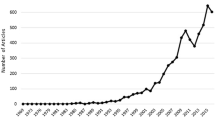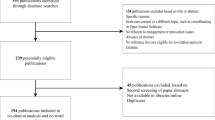Abstract
This paper aims to study the collaboration among researchers in a specific Italian program funding, the Projects of National Interest (PRIN), which supports the academic research. The paper uses two approaches to study the dynamic complex networks: first it identifies the observed distribution of links among researchers in the four areas of interest (chemistry, physics, economics and sociology) through distribution models, then it uses a stochastic model to understand how the links change over time. The analysis is based on large and unique dataset on 4322 researchers from 98 universities and research institutes that have been selected for PRIN allocation from 2000 to 2011. The originality of this work is that we have studied a competitive funding schemes through dynamic network analysis techniques.

Similar content being viewed by others
Notes
The h-index is a measure used to indicated the impact of a researcher based on how often his/her publications have been cited.
With assortativity effect we mean the tendencies for researchers with high h-index to preferably be tied to other researchers with high h-index.
In the models we include variables at a structural level, as well as also control variables.
Markov process means that change probabilities (future) only depend on the current state of the network and not on past configurations.
Also called evaluation function.
This because over time the government’ guidelines about collaborations are changed.
If we had calculated the cluster coefficient per year it would have the value 1 because within each project everybody is linked to everyone else.
Centrality indices were calculated (degree, betweenness and closeness centrality) and we noticed that scientists with lower centrality indices were theoretical physicists.
The model was built selecting only some effects which reasonably drive the evolution of the network among the several effects defined and provided in the package RSiena, through the command “effectsDocumentation”. We chose the ones best suited to our studio and network characteristics.
The PRIN calls have changed since 2005 and after this date has not been possible to participate to the PRIN for two consecutive years.
References
Albert, R., & Barabási, A.-L. (2002). Statistical mechanics of complex networks. Reviews of Modern Physics, 74, 47.
Anand, B., & Khanna, T. (2000). Do firms learn to create value? The case of alliances. Strategic Management Journal, 21, 295–315.
Andersson, K. A. (2011). The formation of collaboration networks among individuals with heterogeneous skills. Working Papers. IDEAS: https://ideas.repec.org/p/cmu/gsiawp/938084531.html#biblio.
Andersson, A., & Persson, O. (1993). Networking scientists. The Annals of Regional Science, 27(1), 11–21.
Arenas, A., Danon, L., Díaz-Guilera, A., Gleiser, P., & Guimerá, R. (2004). Community analysis in social networks. European Physical Journal B, 38(2), 373.
Barabàsi, A. L., & Albert, R. (1999). Emergence of scaling in random networks. Science, 286, 509–512.
Beaver, D. D. (2001). Reflections on scientific collaboration (and its study): Past, present, and future. Scientometrics, 52, 365–377.
Bellotti, E. (2012). Getting funded. Multi-level network of physicists in Italy. Social Networks, 34, 215–229.
Bollen, J., Rodriguez, M. A., & de Sompel, H. V. (2006). Journal status. Scientometrics, 69(3), 669–687.
Bornmann, L., & Marx, W. (2011). The h index as a research performance indicator. European Science Editing, 37(3), 77–80.
Boschma, R. (2005). Proximity and innovation: A critical assessment. Regional Studies, 39(1), 61–74.
Boschma, R. A., & Frenken, K. (2009). The spatial evolution of innovation networks. A proximity perspective. In R. A. Boschma & R. Martin (Eds.), Handbook of evolutionary economic geography. Cheltenham: Edward Elgar.
Chatterjee, A., Yarlagadda, S., & Chakrabarti, B. (2005). Econophysics of wealth distributions. Milan: Springer.
Clauset, A., Shalizi, C. R., & Newman, M. E. (2009). Power-law distributions in empirical data. SIAM Review, 51, 661–703.
Davis, P. M. (2008). Eigenfactor: Does the principle of repeated improvement result in better estimates than raw citation counts? Journal of the American Society for Information Science and Technology, 59(13), 2186–2188.
De Stefano, D., Fuccella, V., Prosperina, V. M., & Zaccarin, S. (2013). The use of different data sources in the analysis of co-authorship networks and scientific performance. Social Networks, 35(3), 370–381.
Durfee, E. H., Lesser, V. R., & Corkill, D. D. (1989). Cooperative distributed problem solving. In A. Barr, P. R. Cohen, & E. A. Feigenbaum (Eds.), The handbook of artificial intelligence IV (pp. 83–127). Reading, Massachusetts: Addison-Wesley.
Fernández, D. A., & López, J. M. V. (2015). Towards a European supranational policy of education based on the European dimension on education. Bordón. Revista de Pedagogía, 67(1), 101–116. doi:10.13042/Bordon.2015.67107.
Gibbons, M., Limoges, C., Nowotny, H., Schwartzman, S., Scott, P., & Trow, M. (1994). The new production of knowledge: The dynamics of science and research in contemporary societies. London: Sage.
Gillespie, C. S. (2015). Fitting heavy tailed distributions: The poweRlaw package. Journal of Statistical Software, 64(2), 1–16. http://www.jstatsoft.org/v64/i02/.
Giot, L., et al. (2003). A protein interaction map of Drosophila melanogaster. Science, 302, 1727–1736.
Gmür, M. (2003). Co-citation analysis and the search for invisible colleges: A methodological evaluation. Scientometrics, 57(1), 27–57.
Hicks, D. M., & Katz, J. S. (1996). Where is science going? Science, Technology and Human Values, 21, 379–406.
Huisman, M., & Snijders, T. A. B. (2003). Statistical analysis of longitudinal network data with changing composition. Sociological Methods & Research, 32(2), 253–287.
Huisman, M., & Steglich, C. E. G. (2008). Treatment of non-response in longitudinal network studies. Social Networks, 30, 297–308.
Hummon, N. P., & Carley, K. (1993). Social networks as normal science. Social Networks, 15, 71–106.
Hummon, N. P., & Doreian, P. (1989). Connectivity in a citation network: The development of DNA theory. Social Networks, 11, 39–63.
Katz, J. S. (1994). Geographical proximity and scientific collaboration. Scientometrics, 31(1), 31–43.
Katz, J. S., & Martin, B. R. (1997). What is research collaboration? Research Policy, 26, 1–18.
Kronegger, L., Mali, F., Ferligoj, A., & Doreian, P. (2012). Collaboration structures in Slovenian scientific communities. Scientometrics, 90(2), 631–647.
Laudel, G. (2002). What do we measure by co-authorships? Research Evaluation, 11, 3–15.
Laudel, G. (2006). The ‘quality myth’: Promoting and hindering conditions for acquiring research funds. Dordrecht: Springer.
Lepori, B., van den Besselaar, P., Dinges, M., Potì, B., Reale, E., Slipersaeter S., et al. (2007). Comparing the evolution of national research policies: What patterns of changes? Science and Public Policy, 34(6), 372–388.
Merton, R. K. (1968). The Matthew effect in science. Science, 159, 53–63.
Newman, M. E. J. (2001a). Clustering and preferential attachment in growing networks. Physical Review E, 64, 025102.
Newman, M. E. J. (2001b). The structure of scientific collaboration networks. Proceedings of the National Academy of Sciences of the United States of America, 98, 404.
Newman, M. E. J. (2004). Who is the best connected scientist? A study of scientific co-authorship networks. In E. Ben-Naim, H. Frauenfelder, & Z. Toroczkai (Eds.), Complex networks (pp. 337–370). Berlin: Springer.
Newman, M. E. J. (2005). Power laws. Pareto distributions and Zipf’s law. Contemporary Physics, 46, 323–351.
Nooteboom, B., Vanhaverbeke, W., Duysters, G., Gilsing, V., & Van Den Oord, A. (2007). Optimal cognitive distance and absorptive capacity. Research Policy, 36, 1016–1034.
Norris, J. (1997). Markov chains. Cambridge: Cambridge University Press.
North, D. C. (1990). Institutions, institutional change and economic performance. Cambridge: Cambridge University Press.
Reale, E, & Zinilli, A. (2014). Evaluation processes in research grant allocation: What is the relevance of scientific quality? In Paper presented at the 27th CHER conference. Rome. 8–10 September.
Robbins, H., & Monro, S. (1951). A stochastic approximation method. Annals of Mathematical Statistics, 22, 400–407.
Scherngell, T., & Lata, R. (2011). Towards an integrated European research area? Findings from Eigenvector spatially filtered spatial interaction models using European Framework Programme data. Papers in Regional Science, 92, 555–577.
Sinha, S. (2006). Evidence for power-law tail of the wealth distribution in India. Physica A, 359, 555–562.
Smith. D. & J. S. Katz (2000). Collaborative approaches to research. A report to the Higher Education Funding Council for England. Centre for Policy Studies in Education, University of Leeds.
Snijders, T. A. B. (1996). Stochastic actor-oriented models for network change. The Journal of mathematical Sociology, 21(1–2), 149–172.
Snijders, T. A. B. (2001). The statistical evaluation of social network dynamics. In M. Sobel & M. Becker (Eds.), Sociological methodology (pp. 361–395). Boston, MA: Basil Blackwell.
Snijders, T. A. B. (2005). Models for longitudinal network data. In P. Carrington, J. Scott, & S. Wasserman (Eds.), Models and methods in social network analysis (pp. 215–247). New York (NY): Cambridge University Press.
Snijders, T. A. B., Steglich, C., Schweinberger, M., & Huisman, M. (2010). Manual for SIENA version 3.2. Provisional version. Oxford: University of Oxford, Department of Statistics.
Vuong, Q. (1989). Likelihood ratio tests for model selection and non-nested hypotheses. Econometrica, 57, 307–333.
Watts, D. J., Dodds, P. S., & Newman, M. E. J. (2002). Identity and search in social networks. Science, 296, 1302–1305.
Watts, D. J., & Strogatz, S. H. (1998). Collective dynamics of’small-world’ networks. Nature, 393, 440–442.
Zinilli, A., & Cerulli, G. (2015). DATANET: A stata procedure to facilitate dataset organization for network analysis, Statistical Software Components, Boston College Department of Economics. http://EconPapers.repec.org/RePEc:boc:bocode:s458033. Published: 06-25-2015.
Acknowledgments
This work has benefitted from helpful comments and suggestions by Emanuela Reale. I would also like to thank Thomas Scherngell and Michael Barber for their advice during my visiting in Vienna granted by the Eu-SPRI PhD Circulation Award.
Author information
Authors and Affiliations
Corresponding author
Rights and permissions
About this article
Cite this article
Zinilli, A. Competitive project funding and dynamic complex networks: evidence from Projects of National Interest (PRIN). Scientometrics 108, 633–652 (2016). https://doi.org/10.1007/s11192-016-1976-4
Received:
Published:
Issue Date:
DOI: https://doi.org/10.1007/s11192-016-1976-4




